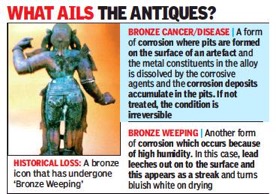Tamil Nadu: antiquities
This is a collection of articles archived for the excellence of their content. |
Chola, Pallava bronzes
Bronze cancer, 2019
Jaya Menon, Bronze cancer hits 1,000s of TN antiques, December 19, 2018: The Times of India

From: Jaya Menon, Bronze cancer hits 1,000s of TN antiques, December 19, 2018: The Times of India
Corrosion Incurable, Contagious
As a court-appointed ASI team painstakingly scrutinises the antiquity of idols stored in safety vaults in temples across Tamil Nadu, some disturbing facts have come to light. The team found that a significant percentage of the 1,100 idols screened so far in the Tiruvarur icon centre, which houses at least 4,380 antiques, suffer from what’s called bronze disease. Some experts refer to it as bronze cancer, the chloride corrosion of idols that, they say, is incurable and sometimes contagious.
With few or no protocols in place for conservation, hundreds of idols have been crammed into icon centres without proper light and in uncontrolled environment. The ongoing elaborate exercise is equivalent to a detailed audit, probably the first such being carried out in the state. While the expert team, comprising ASI officials and idol experts, has a long way to go as it visits one icon centre after another to check if the idols are original Chola or Pallava-era antiques, the scant regard for their proper preservation in vaults is proving to be a big challenge.
Dr B Venkatraman, director, health safety and environment group, Indira Gandhi Centre For Atomic Research, told TOI that bronze disease was detected among the 900-odd idols that were sent to him for analysis.
On ASI’s direction, IGCAR has taken up artistic evaluation and historical documentation along with X-ray fluorescence analysis to ascertain the chemical composition of the idols, he said. “Some of these problems are inevitable since the icons are made of metal, which, unlike stone, is a corrosive material,” said Bengaluru-based Prof Sharada Srinivasan, who is a member of the Advisory Board of the Institute of Archaeometallurgical Studies, London. “Copper-bronze alloys in particular tend to be susceptible to bronze disease due to possible contamination by chloride salts,” she said. This results in chloride corrosion whereby initially light green spots form and if unchecked, it can be irreversible and affect the entire artefact.